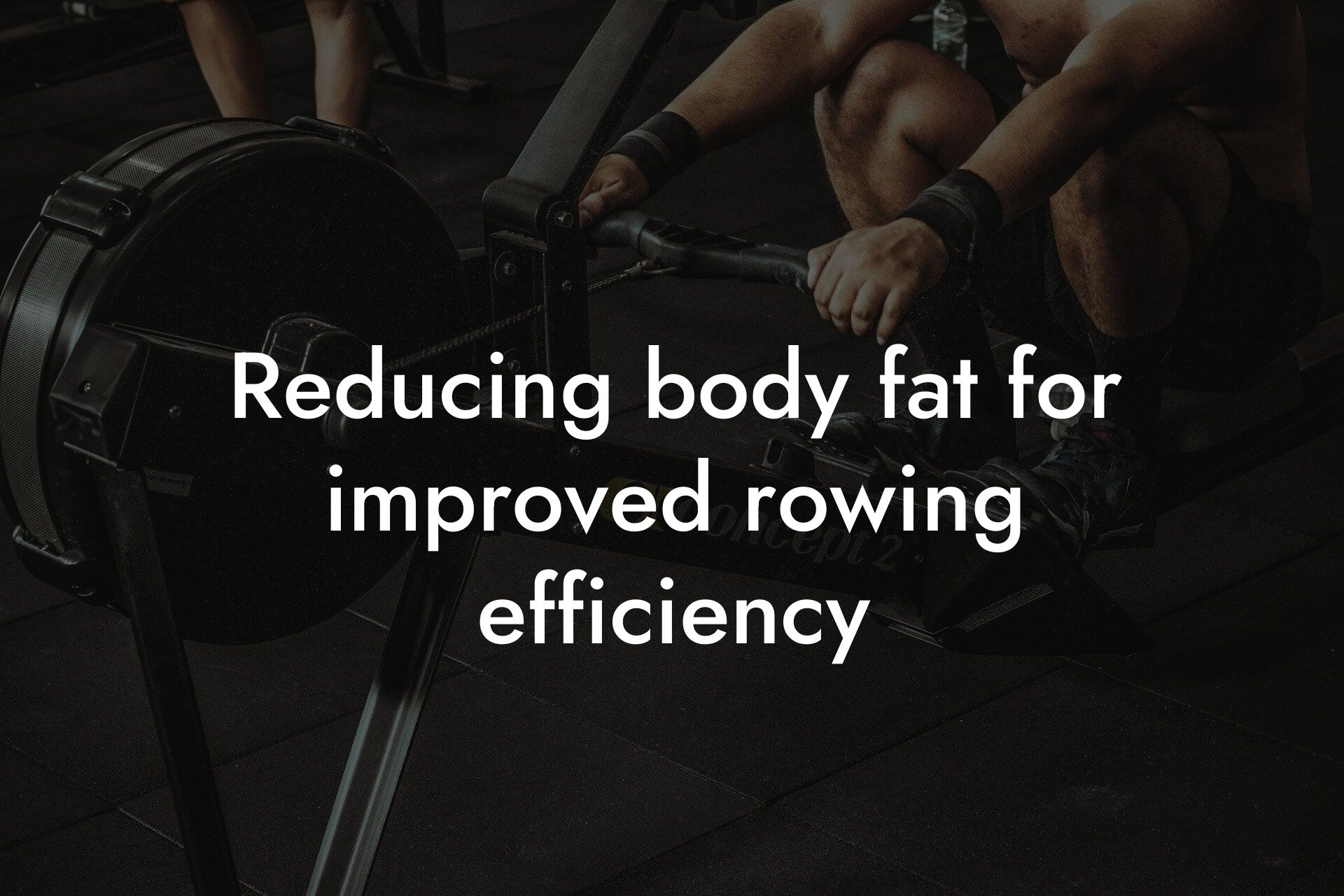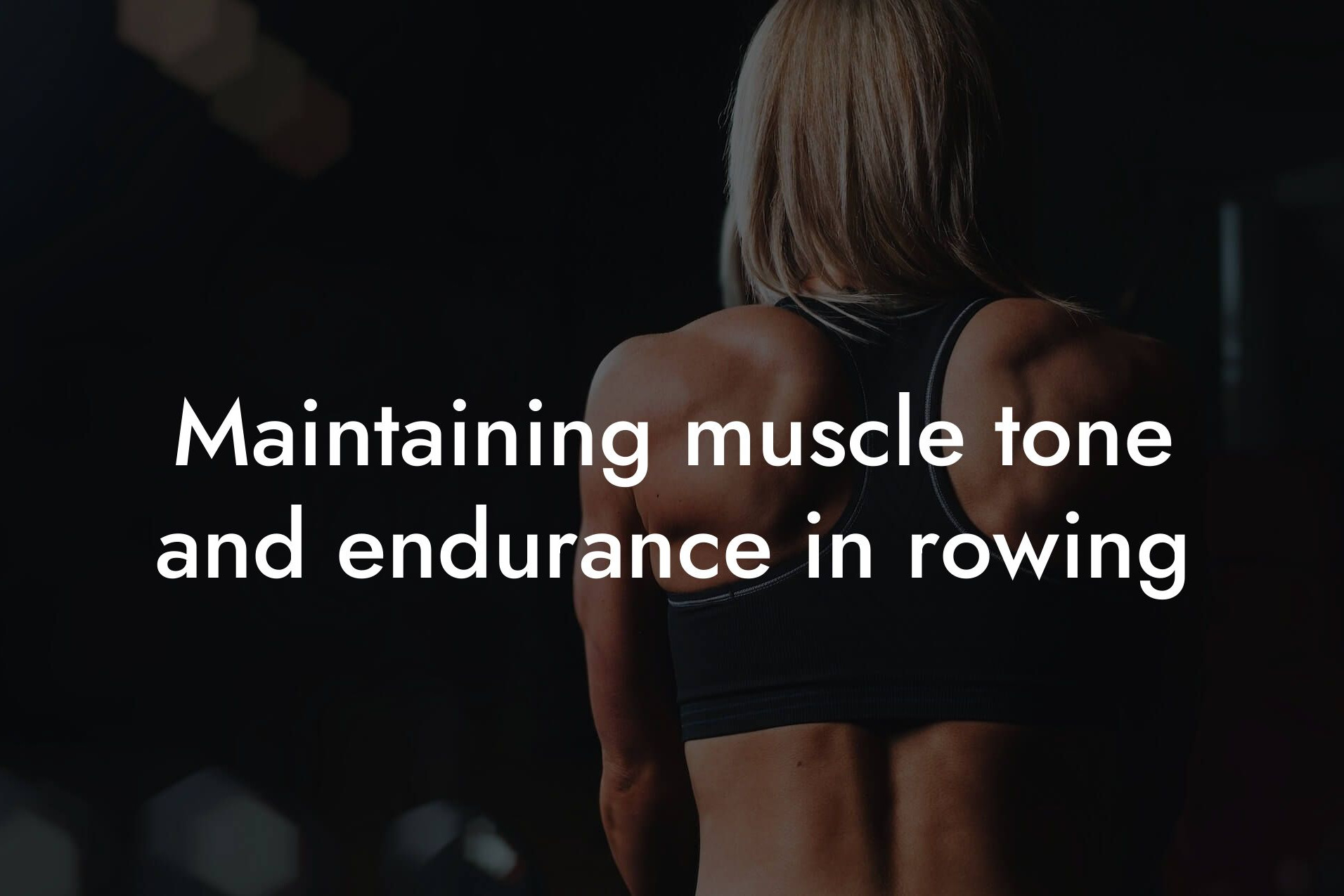As a high-earning professional, you understand the importance of maintaining a strong and healthy physique to keep up with the demands of your busy lifestyle. Rowing is an excellent way to improve cardiovascular fitness and build endurance, but incorporating strength training into your routine can take your performance to the next level. At Tano Performance Group, we're committed to providing you with the knowledge and tools you need to optimize your physical performance. In this article, we'll explore the benefits of strength training for rowers and provide you with actionable tips to incorporate into your routine.
Table of Contents
Why Strength Training is Essential for Rowers
Rowing is a physically demanding sport that requires a combination of endurance, strength, and technique. While cardiovascular exercise is essential for building endurance, strength training is critical for improving power, speed, and overall performance. By incorporating strength training into your routine, you can:
• Increase your power output and speed on the water
• Improve your endurance and reduce fatigue
• Enhance your overall athleticism and coordination
• Reduce your risk of injury by strengthening your muscles and connective tissues
Key Muscle Groups for Rowers
When it comes to strength training for rowing, it's essential to focus on exercises that target the key muscle groups used in the sport. These include:
• Latissimus dorsi: responsible for pulling the oar towards your body
• Rhomboids: involved in scapular rotation and stability
• Trapezius: helps to stabilize the scapula and rotate the shoulder blade
• Deltoids: responsible for flexion and rotation of the shoulder joint
• Core muscles: essential for stability, balance, and power transfer
• Legs: important for generating power and driving the stroke
Essential Exercises for Rowers
Here are some essential exercises to incorporate into your strength training routine:
• Deadlifts: targets the legs, glutes, and lower back
• Bent-over rows: targets the latissimus dorsi, rhomboids, and trapezius
• Dumbbell rows: targets the latissimus dorsi and rhomboids
• Shoulder press: targets the deltoids and trapezius
• Planks: targets the core muscles
• Leg press: targets the legs and glutes
Periodization and Programming
To get the most out of your strength training routine, it's essential to incorporate periodization and programming principles. This involves:
• Alternating between high-intensity and low-intensity training phases
• Focusing on specific muscle groups and exercises during each phase
• Gradually increasing the weight, reps, or sets over time to continue challenging your muscles
• Incorporating active recovery techniques, such as foam rolling and stretching, to aid in muscle recovery
Incorporating Strength Training into Your Rowing Routine
So, how do you incorporate strength training into your rowing routine? Here are some tips:
• Aim to strength train 2-3 times per week, with at least one day of rest in between
• Start with lower weights and higher reps (12-15) to focus on endurance and muscle tone
• Gradually increase the weight and lower the reps (8-10) as you build strength and power
• Incorporate strength training exercises into your warm-up or cool-down routine
• Use resistance bands or bodyweight exercises as a convenient and portable alternative to weightlifting
Common Mistakes to Avoid
When it comes to strength training for rowing, there are several common mistakes to avoid:
• Focusing too much on cardio and neglecting strength training
• Not incorporating exercises that target the core and legs
• Not periodizing your training and sticking to the same routine for too long
• Not listening to your body and ignoring signs of fatigue or injury
Monitoring Your Progress
At Tano Performance Group, we understand the importance of tracking your progress and making data-driven decisions. Our DEXA machine provides a comprehensive body assessment, giving you valuable insights into your body composition, bone density, and muscle mass. By tracking your progress regularly, you can:
• Identify areas for improvement and adjust your training routine accordingly
• Monitor your progress and stay motivated
• Make informed decisions about your nutrition and recovery strategies
Incorporating strength training into your rowing routine can have a significant impact on your performance and overall physique. By focusing on exercises that target the key muscle groups used in rowing, periodizing your training, and monitoring your progress, you can take your rowing to the next level. Remember to stay committed, stay consistent, and stay informed – and you'll be on your way to achieving your fitness goals in no time.
Frequently Asked Questions
What is the importance of strength training for rowers?
Strength training is essential for rowers as it helps to improve their overall performance, increase power, and reduce the risk of injury. By incorporating strength training into their routine, rowers can develop stronger muscles, tendons, and ligaments, which enables them to generate more force and speed on the water.
How does strength training complement rowing?
Strength training complements rowing by improving muscular endurance, power, and efficiency. It helps rowers to maintain a strong and stable posture, generate more force, and sustain it over a longer period. Additionally, strength training can help to improve rowing technique, reduce fatigue, and enhance overall performance.
What are the key muscle groups that rowers should focus on?
Rowers should focus on strengthening their legs, core, back, and arms. The legs provide the power and drive, the core provides stability and control, the back provides the foundation for the rowing motion, and the arms provide the finishing touch. Strengthening these muscle groups can help to improve overall rowing performance.
What are some effective strength training exercises for rowers?
Some effective strength training exercises for rowers include squats, lunges, deadlifts, bench press, rows, and leg press. These exercises target the key muscle groups used in rowing and can help to improve power, strength, and endurance.
How often should rowers incorporate strength training into their routine?
Rowers should aim to incorporate strength training into their routine 2-3 times per week, with at least one day of rest in between. This allows for adequate recovery time and helps to prevent overtraining and injury.
What is the ideal strength training routine for a beginner rower?
For a beginner rower, it's essential to start with a routine that focuses on building overall strength and endurance. A good starting point would be to focus on exercises such as bodyweight squats, lunges, push-ups, and rows, and gradually progress to more advanced exercises as strength and endurance improve.
How can rowers incorporate strength training into their busy schedules?
Rowers can incorporate strength training into their busy schedules by setting aside dedicated time for strength training, using a home gym or online workout programs, and focusing on exercises that can be done in a short amount of time. Additionally, rowers can try to incorporate strength training into their daily routine, such as doing a few exercises during commercial breaks while watching TV.
What are some common mistakes that rowers make when it comes to strength training?
Some common mistakes that rowers make when it comes to strength training include not incorporating enough variety into their routine, not focusing on proper form and technique, and not allowing for adequate recovery time. Additionally, rowers may make the mistake of not incorporating strength training into their routine at all, which can lead to plateaus and decreased performance.
How can rowers measure the effectiveness of their strength training routine?
Rowers can measure the effectiveness of their strength training routine by tracking their progress through metrics such as increased strength, improved endurance, and enhanced overall performance. Additionally, rowers can use tools such as heart rate monitors and GPS tracking devices to measure their progress and make adjustments to their routine as needed.
What are some common injuries that rowers may experience, and how can strength training help to prevent them?
Common injuries that rowers may experience include lower back strain, shoulder injuries, and knee problems. Strength training can help to prevent these injuries by improving muscular strength and endurance, increasing flexibility and mobility, and enhancing overall stability and control.
How can rowers incorporate strength training into their off-season training?
Rowers can incorporate strength training into their off-season training by focusing on building overall strength and endurance, and using exercises that target specific muscle groups used in rowing. Additionally, rowers can use the off-season to try new exercises and techniques, and to work on improving their overall fitness and athleticism.
What are some benefits of strength training for rowers beyond improved performance?
Beyond improved performance, strength training can provide numerous benefits for rowers, including increased bone density, improved body composition, enhanced overall health and wellness, and increased confidence and self-esteem.
How can rowers incorporate strength training into their warm-up and cool-down routines?
Rowers can incorporate strength training into their warm-up and cool-down routines by using exercises that target specific muscle groups used in rowing, such as leg swings, arm circles, and torso twists. This can help to improve flexibility, mobility, and overall performance.
What are some strength training exercises that can be done on the water?
Some strength training exercises that can be done on the water include rowing sprints, high-intensity interval training, and strength-based drills such as "power 10s" and "strength 20s". These exercises can help to improve power, strength, and endurance, and can be incorporated into a rower's on-water training routine.
How can rowers incorporate strength training into their cross-training routine?
Rowers can incorporate strength training into their cross-training routine by using exercises that target specific muscle groups used in rowing, such as cycling, running, and swimming. This can help to improve overall fitness and athleticism, and can provide a change of pace from traditional rowing training.
What are some common myths about strength training for rowers?
Some common myths about strength training for rowers include the idea that strength training will make them "bulky" or slow, or that it's only necessary for elite-level rowers. However, strength training is essential for rowers of all levels, and can help to improve performance, reduce the risk of injury, and enhance overall fitness and athleticism.
How can rowers find a qualified strength training coach or personal trainer?
Rowers can find a qualified strength training coach or personal trainer by doing research online, asking for referrals from other rowers or coaches, and looking for certifications such as USA Weightlifting or National Strength and Conditioning Association (NSCA). It's essential to find a coach or trainer who has experience working with rowers and understands the specific demands of the sport.
What are some online resources that rowers can use to learn more about strength training?
Rowers can use online resources such as websites, blogs, and social media platforms to learn more about strength training. Additionally, rowers can use online workout programs and apps to access strength training exercises and routines, and to track their progress and stay motivated.
How can rowers stay motivated and consistent with their strength training routine?
Rowers can stay motivated and consistent with their strength training routine by setting specific and achievable goals, tracking their progress, and finding a workout buddy or accountability partner. Additionally, rowers can reward themselves for reaching milestones, and celebrate their progress and successes along the way.
What are some strength training exercises that can be done at home with minimal equipment?
Rowers can do strength training exercises at home with minimal equipment, such as bodyweight squats, lunges, push-ups, and rows. Additionally, rowers can use resistance bands, dumbbells, and kettlebells to add variety and challenge to their workouts.
How can rowers incorporate strength training into their travel routine?
Rowers can incorporate strength training into their travel routine by using hotel gyms, finding local gyms or studios, and doing bodyweight exercises in their hotel room. Additionally, rowers can use online workout programs and apps to access strength training exercises and routines, and to stay motivated and accountable while on the road.
What are some strength training exercises that can be done in a short amount of time?
Rowers can do strength training exercises in a short amount of time, such as 10-15 minute workouts, by focusing on high-intensity interval training, plyometric exercises, and strength-based drills. This can help to improve power, strength, and endurance, even with a limited amount of time.
Here are some related articles you might love...
- Reducing body fat for improved rowing efficiency
- Balancing strength and endurance in rowing
- Maintaining muscle tone and endurance in rowing
- Recovery techniques for rowers after intense sessions
- How body composition impacts rowing performance
- The role of rowing in cardiovascular health
- Using DEXA scans to monitor progress in rowing
- Bone density and its role in rowing performance
- Nutrition strategies for sustained energy during rowing workouts
Zak Faulkner
Zak Faulkner is a leading authority in the realm of physical health and body composition analysis, with over 15 years of experience helping professionals optimise their fitness and well-being. As one the experts behind Tano Performance Group, Zak has dedicated his career to providing in-depth, science-backed insights that empower clients to elevate their physical performance and overall health.
With extensive knowledge of DEXA technology, Zak specializes in delivering comprehensive body assessments that offer precise data on body fat, muscle mass, bone density, and overall physique. His expertise enables individuals to make informed decisions and achieve their fitness goals with accuracy and confidence. Zak’s approach is rooted in a deep understanding of human physiology, combined with a passion for helping clients unlock their full potential through personalised strategies.
Over the years, Zak has earned a reputation for his commitment to excellence, precision, and client-focused service. His guidance is trusted by top professionals who demand the best when it comes to their health. Whether advising on fitness programs, nutritional strategies, or long-term wellness plans, Zak Faulkner’s insights are a valuable resource for anyone serious about taking their health and fitness to the next level.
At Tano Performance Group, Zak continues to lead our Content Team revolutionising how professionals approach their physical health, offering unparalleled expertise that drives real results.




